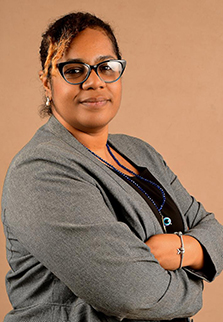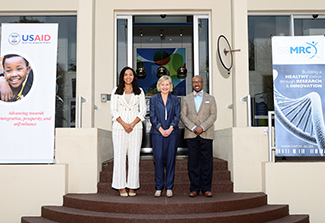USAID awards $45 million to African scientists developing HIV vaccine
January/February 2024 | Volume 23 Number 1
By Susan Scutti
 Photo courtesy of Sophia Osawe Dr. Sophia Osawe, a member of the BRILLIANT Consortium and former Fogarty fellow, works at the international research center of the Institute of Human Virology in Nigeria.
Photo courtesy of Sophia Osawe Dr. Sophia Osawe, a member of the BRILLIANT Consortium and former Fogarty fellow, works at the international research center of the Institute of Human Virology in Nigeria.
The
South African Medical Research Council (SAMRC) received a grant worth more than $45 million to implement the HIV Vaccine Innovation, Science, and Technology Acceleration in Africa (HIV-VISTA) program. SAMRC President and CEO and former Fogarty trainee, Dr. Glenda Gray guided the application process for this grant from the U.S. Agency for International Development (USAID).
To compete for funding, Gray established the
BRILLIANT consortium (BRinging Innovation to cLinical and Laboratory research to end HIV In Africa through New vaccine Technology). BRILLIANT, which includes scientists from eight African countries, will design and implement early-stage clinical trials of HIV vaccine immunogens and conduct laboratory analyses and epidemiological studies.
The consortium plans to test HIV vaccine concepts and advance the most promising candidates while working with existing scientific talent and community engagement channels in sub-Saharan Africa (SSA). As part of its SSA-led HIV vaccine effort, consortium members plan to partner with policymakers, affected communities (including people living with HIV/AIDS), advocates, and communicators. A complementary goal of the consortium is to strengthen systems of collaboration throughout SSA while increasing career opportunities for promising regional scientists. One such scientist is Dr. Sophia Osawe, who has been working at the Institute for Human Virology in Nigeria (IHVN) for the past 16 years.
Developing skills while developing a vaccine
In her role at IHVN, Osawe, a former Fogarty Global Health Fellow who recently defended her PhD in medical microbiology and immunology, writes, implements, and manages grants, and coordinates researchers and study participants. Osawe sees BRILLIANT as an opportunity “to develop more of my skills in the lab and in immunology, interact with other early career researchers, and just continue improving my ability to write grants and help implement studies in my community.”
To date, a vaccine to sustainably control the HIV pandemic has been elusive. UNAIDS estimates that 1.3 million people became newly infected in 2022, with almost two-thirds of these new infections occurring in SSA. And while women and girls accounted for 50% of new infections globally, they accounted for 63% of all new infections in SSA. Already, there are twice as many young SSA women as men between the ages of 15 and 24 living with HIV, and they struggle to access treatment and prevention due to stigma and policies. BRILLIANT sees communities as a central part of its effort to design a pivotal HIV vaccine, and so it includes community representatives in all its decision-making bodies.
In the absence of a vaccine, scientists have made significant progress combating HIV and achieving some control over the epidemic. New biomedical tools, such as pre-exposure prophylaxis, offer promise for continuing to reduce HIV incidence. Still, a safe, effective and affordable HIV vaccine could enable a more profound, rapid, and cost-effective rate of reduction. Experts believe it is crucial that HIV vaccine candidates be designed to neutralize virus types prevalent in the SSA region, where most new infections occur.
Osawe said, “Nigeria is the only West African country involved in the consortium, so we’re very excited. Hopefully we will be a site chosen to implement a HIV vaccine trial in our population.” Through IHVN, she’s worked with colleagues in other countries in the past. One project she helped implement in Nigeria and South Africa focused on mothers living with HIV and their infants. The differences across communities, cohorts and operational systems taught both teams more about recruitment and retention strategies. Osawe noted that the Nigerian mothers were less likely to drop out of the study compared to the South African mothers, partly because they were more often married and so found participation, including traveling to the study site, easier. To boost retention of the South African mothers, the teams shared their experiences and retention strategies.
“I've grown over the years interacting with and learning from the different groups that we work with, so it's very important to have that mix,” said Osawe. “We learn from each other how to improve what we do to help our communities."
 Photo courtesy of SAMRC From left: Paloma Adams-Allen (Deputy Administrator of the USAID) , Dr. Glenda Gray (SAMRC President and CEO) and Reuben Brigety (United States Ambassador to South Africa)
Photo courtesy of SAMRC From left: Paloma Adams-Allen (Deputy Administrator of the USAID) , Dr. Glenda Gray (SAMRC President and CEO) and Reuben Brigety (United States Ambassador to South Africa)
Lessons learned from regional burden
Over the past two decades, SAMRC has conducted essential research on HIV and related conditions. South African scientists collaborating with SAMRC are ranked among the world’s best in all aspects of the HIV response, including prevention of HIV infection from mother to child, the development of newer and safer drug regimens, and the health service delivery of antiretroviral treatment and preventions. USAID’s investment, then, is not just a financial contribution, it's a beacon of hope for HIV vaccine discovery in Africa, stated Gray in a press release.
Dr. Linda-Gail Bekker, a BRILLIANT scientist and a former Fogarty trainee who is now director and CEO of the Desmond Tutu HIV Centre and Health Foundation, commented, “Africa has borne an enormous burden of the HIV epidemic, and it is fitting that our continent plays a significant role in bringing an effective, affordable and accessible HIV vaccine to the world.”
Fogarty's Impact
The BRILLIANT consortium also boasts three other former Fogarty trainees and grant recipients: Osawe’s colleague at IHVN, Dr. Evaezi Okpokoro; Dr. Penny Moore of the National Institute for Communicable Diseases/University of Witwatersrand, South Africa; and Dr. Wilbert Mbuya of the National Institute for Medical Research, Tanzania. All are well acquainted with the challenges of conducting research in low- and middle-income countries.
As a SSA researcher, Osawe contends with many difficulties, she told Fogarty, including traveling to hard-to-reach regions—because of a lack of road infrastructure, political volatility or regional crises—and providing additional safety measures for refrigerated samples in areas where power outages can occur. Still, she said, “I love what I do. When I was little, I was very curious about my surroundings, I was very curious about how people fell ill. Now, I'm able to contribute my own part to help my community. Overall, it has been fulfilling. And it's just important to be fulfilled in life.”
More Information
Updated February 14, 2024
To view Adobe PDF files,
download current, free accessible plug-ins from Adobe's website.
Related World Regions / Countries
Related Global Health Research Topics